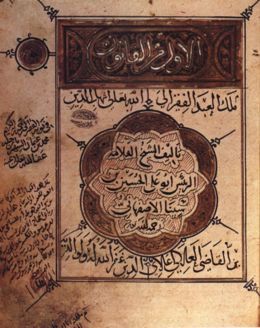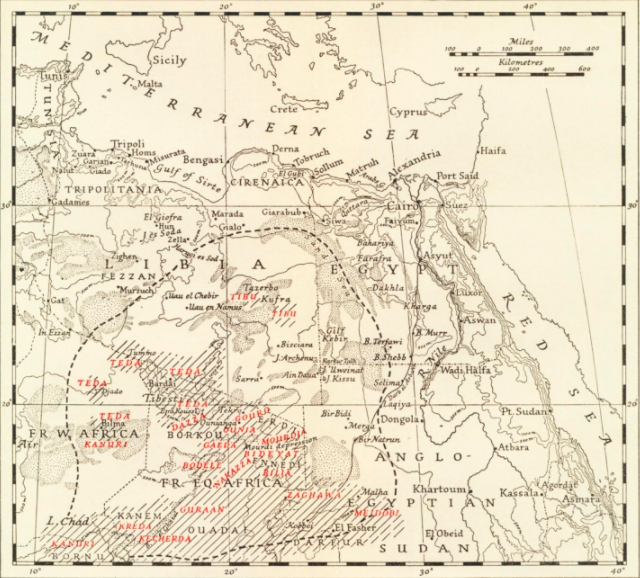|
Kanem–Bornu Empire
The Kanem–Bornu Empire existed in areas which are now part of Nigeria, Niger, Cameroon and Chad. It was known to the Arabian geographers as the Kanem Empire from the 8th century AD onward and lasted as the independent kingdom of Bornu (the Bornu Empire) until 1900. The Kanem Empire (c. 700–1380) was located in the present countries of Chad, Nigeria and Libya. At its height, it encompassed an area covering not only most of Chad but also parts of southern Libya (Fezzan) and eastern Niger, northeastern Nigeria and northern Cameroon. The Bornu Empire (1380s–1893) was a state in what is now northeastern Nigeria, in time becoming even larger than Kanem, incorporating areas that are today parts of Chad, Niger, Sudan, and Cameroon. The early history of the empire is mainly known from the Royal Chronicle, or '' Girgam'', discovered in 1851 by the German traveller Heinrich Barth. Remnant successor regimes of the empire, in form of the Borno Emirate and Dikwa Emirate, were establis ... [...More Info...] [...Related Items...] OR: [Wikipedia] [Google] [Baidu] |
Bornu Empire
Bornu may refer to: * Bornu Empire, a historical state of West Africa * Borno State, Nigeria {{disambig ... [...More Info...] [...Related Items...] OR: [Wikipedia] [Google] [Baidu] |
Borno Emirate
The Borno Emirate or Borno Sultanate is a traditional Nigerian state formed at the start of the 20th century. It is headed by descendants of the rulers of the Bornu Empire, founded before 1000. The rulers have the title Shehu of Borno (var. Shehu of Bornu, Sultan of Borno/u). The traditional Emirate of Borno maintains a ceremonial rule of the Kanuri people, based in Maiduguri, Borno State, Nigeria, but acknowledged by the 4 million Kanuri in neighbouring countries. The current ruling line, the al-Kanemi dynasty, dates to the accession of Muhammad al-Amin al-Kanemi in the early 19th century, displacing the Sayfawa dynasty which had ruled from around 1300. History The old Bornu Empire collapsed in 1893 when the Funj warlord Rabih Zubayr ibn Fadlallah seized power and transferred the capital to Dikwa. The French, then expanding in West Africa, defeated and killed Rabih they installed Shehu Sanda Kura, a member of the old Bornu dynasty, as the first Shehu of Borno in Dikwa in 190 ... [...More Info...] [...Related Items...] OR: [Wikipedia] [Google] [Baidu] |
Kitāb Al-Fihrist
The ''Kitāb al-Fihrist'' ( ar, كتاب الفهرست) (''The Book Catalogue'') is a compendium of the knowledge and literature of tenth-century Islam compiled by Ibn Al-Nadim (c.998). It references approx. 10,000 books and 2,000 authors.''The Biographical Dictionary of the Society for the Diffusion of Useful Knowledge'', Volume 2, Numero 2, p. 782 This crucial source of medieval Arabic-Islamic literature, informed by various ancient Hellenic and Roman civilizations, preserves from his own hand the names of authors, books and accounts otherwise entirely lost. ''Al-Fihrist'' is evidence of Al-Nadim's thirst for knowledge among the exciting sophisticated milieu of Baghdad's intellectual elite. As a record of civilisation transmitted through Muslim culture to the Western world, it provides unique classical material and links to other civilisations. Content The ''Fihrist'' indexes authors, together with biographical details and literary criticism. Al-Nadim's interest ranges from r ... [...More Info...] [...Related Items...] OR: [Wikipedia] [Google] [Baidu] |
Ibn Al-Nadim
Abū al-Faraj Muḥammad ibn Isḥāq al-Nadīm ( ar, ابو الفرج محمد بن إسحاق النديم), also ibn Abī Ya'qūb Isḥāq ibn Muḥammad ibn Isḥāq al-Warrāq, and commonly known by the '' nasab'' (patronymic) Ibn al-Nadīm ( ar, ابن النديم; died 17 September 995 or 998) was an Arab Muslim bibliographer and biographer of Baghdad who compiled the encyclopedia ''Kitāb al-Fihrist'' (''The Book Catalogue''). Biography Much known of al-Nadim is deduced from his epithets. 'Al-Nadim' (), 'the Court Companion' and 'al-Warrāq () 'the copyist of manuscripts'. Probably born in Baghdad ca. 320/932 he died there on Wednesday, 20th of Shaʿban A.H. 385. He was a Persian or perhaps an Arab. From age six, he may have attended a ''madrasa'' and received comprehensive education in Islamic studies, history, geography, comparative religion, the sciences, grammar, rhetoric and Qurʾanic commentary. Ibrahim al-Abyari, author of ''Turāth al-Insaniyah'' says al-Nad ... [...More Info...] [...Related Items...] OR: [Wikipedia] [Google] [Baidu] |
Muhammad Ibn Musa Al-Khwarizmi
Muḥammad ibn Mūsā al-Khwārizmī ( ar, محمد بن موسى الخوارزمي, Muḥammad ibn Musā al-Khwārazmi; ), or al-Khwarizmi, was a Persian polymath from Khwarazm, who produced vastly influential works in mathematics, astronomy, and geography. Around 820 CE, he was appointed as the astronomer and head of the library of the House of Wisdom in Baghdad.Maher, P. (1998), "From Al-Jabr to Algebra", ''Mathematics in School'', 27(4), 14–15. Al-Khwarizmi's popularizing treatise on algebra (''The Compendious Book on Calculation by Completion and Balancing'', c. 813–833 CEOaks, J. (2009), "Polynomials and Equations in Arabic Algebra", ''Archive for History of Exact Sciences'', 63(2), 169–203.) presented the first systematic solution of linear and quadratic equations. One of his principal achievements in algebra was his demonstration of how to solve quadratic equations by completing the square, for which he provided geometric justifications. Because he was the first ... [...More Info...] [...Related Items...] OR: [Wikipedia] [Google] [Baidu] |
Wahb Ibn Munabbih
Wahb ibn Munabbih ( ar, وهب بن منبه) was a Yemenite Muslim traditionist of Dhimar (two days' journey from Sana'a) in Yemen; died at the age of ninety, in a year variously given by Arabic authorities as 725, 728, 732, and 737 C.E. He was a member of Banu Alahrar (Sons of the free people), a Yemeni of Persian origin. He is counted among the Tabi‘in and a narrator of Isra'iliyat. Biography Wahb's father, Munabbih ibn Kamil, had been a convert to Islam and a companion of Muhammad. Wahb himself had turned from Judaism to Islam, according to ''Al-Tibr al-Masluk'' (ed. 1306 A.H., p. 41). Other biographers such as Al-Nawawi and Ibn Khallikan, did not write that he was Jewish. The fact that he was well versed in the Isra'iliyyat, on which he wrote much, probably gave rise to the statement that he was Jewish, although he might have acquired his knowledge from his teacher Ibn 'Abbas. Wahb was made a judge during the reign of Umar ibn Abd al-Aziz.http://www.ghazali.o ... [...More Info...] [...Related Items...] OR: [Wikipedia] [Google] [Baidu] |
Toubou
The Toubou or Tubu (from Old Tebu, meaning "rock people") are an ethnic group native to the Tibesti Mountains that inhabit the central Sahara in northern Chad, southern Libya and northeastern Niger. They live either as herders and nomads or as farmers near oases. Their society is clan-based, with each clan having certain oases, pastures and wells. The Toubou are generally divided into two closely related groups: the Teda (or Téda, Toda) and the Dazagara (or Dazzaga, Dazagada, Daza). They are believed to share a common origin and speak the Tebu languages, which are from the Saharan branch of the Nilo-Saharan language family. Tebu is divided further into two closely related languages, called ''Tedaga'' (Téda Toubou) and '' Dazaga'' (Dazaga Gouran). Of the two groups, the Daza, found to the south of the Teda, are more numerous. The Toubou people are also referred to as the Tabu, Tebu, Tebou, Tibu, Tibbu, Toda, Todga, Todaga, Tubu, Tuda, Tudaga, or Gorane people. The Dazaga a ... [...More Info...] [...Related Items...] OR: [Wikipedia] [Google] [Baidu] |
Dazaga Language
Daza (also known as Dazaga) is a Nilo-Saharan language spoken by the Daza people inhabiting northern Chad. The Daza are also known as the Gouran (Gorane) in Chad. Dazaga is spoken by around 380,000 people, primarily in the Djurab Desert region and the Borkou region, locally called Haya or Faya-Largeau northern-central Chad, the capital of the Dazaga people. Dazaga is spoken in the Tibesti Mountains of Chad (330,000 speakers), in eastern Niger near N'guigmi and to the north (50,000 speakers). It is also spoken to a smaller extent in Libya and in Sudan, where there is a community of 3,000 speakers in the city of Omdurman. There's also a small diaspora community working in Jeddah, Saudi Arabia. The two primary dialects of the Dazaga language are Daza and Kara, but there are several other mutually intelligible dialects, including Kaga, Kanobo, Taruge and Azza. It is closely related to the Tedaga language, spoken by the Teda, the other out of the two Toubou people groups, w ... [...More Info...] [...Related Items...] OR: [Wikipedia] [Google] [Baidu] |
Teda Language
The Teda language, also known as Tedaga, is a Nilo-Saharan language spoken by the Teda, a northern subgroup of the Toubou people that inhabits southern Libya, northern Chad and eastern Niger. Along with the more populous southern dialect of Daza Daza may refer to * Toubou people in northern Africa * Daza language * Dazawa language also known as Daza, spoken in Nigeria *Daza (surname) Daza is a surname of the following people *Camilo Daza (1898–1975), Colombian aviator **Camilo Daza Inte ..., the northern Teda dialect constitutes one of the two varieties of Tebu. However, Teda is also sometimes used for Tebu in general. References * Barth, Heinrich 1854. Schreiben an Prof. Lepsius über die Beziehung der Kanori- und Teda-Sprachen. ''Zeitschrift fur Erdkunde'', 2: 372-74, 384-87. * Chonai, Hassan 1998. ''Gruppa teda-kanuri (centraľnosaxarskaja sem’ja jazykov) i ee genetičeskie vzaimootnošenija (ėtimologičeskij i fonologičeskij aspekt).'' Moskva: PhD. Dissertation (Ross ... [...More Info...] [...Related Items...] OR: [Wikipedia] [Google] [Baidu] |
Nomad
A nomad is a member of a community without fixed habitation who regularly moves to and from the same areas. Such groups include hunter-gatherers, pastoral nomads (owning livestock), tinkers and trader nomads. In the twentieth century, the population of nomadic pastoral tribes slowly decreased, reaching an estimated 30–40 million nomads in the world . Nomadic hunting and gathering—following seasonally available wild plants and game—is by far the oldest human subsistence method. Pastoralists raise herds of domesticated livestock, driving or accompanying them in patterns that normally avoid depleting pastures beyond their ability to recover. Nomadism is also a lifestyle adapted to infertile regions such as steppe, tundra, or ice and sand, where mobility is the most efficient strategy for exploiting scarce resources. For example, many groups living in the tundra are reindeer herders and are semi-nomadic, following forage for their animals. Sometimes also described as " ... [...More Info...] [...Related Items...] OR: [Wikipedia] [Google] [Baidu] |
Confederation
A confederation (also known as a confederacy or league) is a union of sovereign groups or states united for purposes of common action. Usually created by a treaty, confederations of states tend to be established for dealing with critical issues, such as defense, foreign relations, internal trade or currency, with the central government being required to provide support for all its members. Confederalism represents a main form of intergovernmentalism, which is defined as any form of interaction around states which takes place on the basis of sovereign independence or government. The nature of the relationship among the member states constituting a confederation varies considerably. Likewise, the relationship between the member states and the general government and the distribution of powers among them varies. Some looser confederations are similar to international organisations. Other confederations with stricter rules may resemble federal systems. Since the member states o ... [...More Info...] [...Related Items...] OR: [Wikipedia] [Google] [Baidu] |
Lake Chad
Lake Chad (french: Lac Tchad) is a historically large, shallow, endorheic lake in Central Africa, which has varied in size over the centuries. According to the ''Global Resource Information Database'' of the United Nations Environment Programme, it shrank by as much as 95% from about 1963 to 1998. The lowest area was in 1986, at , but "the 2007 (satellite) image shows significant improvement over previous years." Lake Chad is economically important, providing water to more than 30 million people living in the four countries surrounding it (Chad, Cameroon, Niger, and Nigeria) on the central part of the Sahel. It is the largest lake in the Chad Basin. Geography and hydrology The freshwater lake is located in the Sahelian zone of West-central Africa. It is located in the interior basin which used to be occupied by a much larger ancient sea sometimes called Mega Chad. The lake is historically ranked as one of the largest lakes in Africa. Its surface area varies by season as well a ... [...More Info...] [...Related Items...] OR: [Wikipedia] [Google] [Baidu] |






